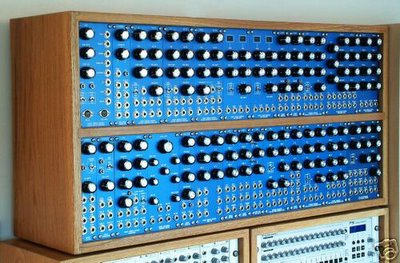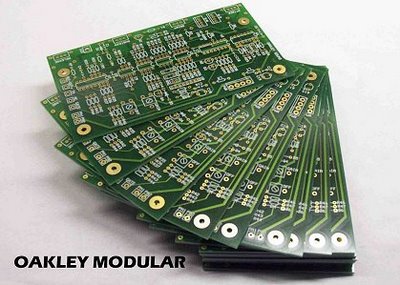
"Custom built “one off” large format Modular Synthesiser in Mint condition and perfect working order. It has been custom built from the very best of Oakley Sound, MOTM, Blacet, Encore and Tellun System modules, with custom engraved stunning looking electric blue front panels and a solid American Oak case. It has been designed and built to the highest standards, and has two separate power supplies, a Power One 1.7Amp PSU for analog modules and a Power One 800ma PSU for the “dirtier” digital modules. This arrangement keeps the soundpath noise free.
I built this modular without regard to cost and for my own personal use, it has a wide variety of filters so that as well as making all of the usual (and unusual J )modular sounds, it will also mimic a lot of old school Analog synths – the Oakley VCO’s are based on the Minimoog core, so in conjunction with the Oakley Superladder moog filter you can get perfect Minimoog and Moog Modular sounds, or use the MOTM 440 for Pro 5 sounds, the MOTM420 for Korg MS20 sounds, The MOTM410 for Korg PS3200 sounds, the MOTM480 for Yamaha CS80, the MOTM485 for Yamaha GX1 etc. BUT it also includes 2 Blacet Miniwaves with optional PPG wavetable ROMS, so wire in a couple of the Miniwaves and use them with the MOTM440 filter and you have instant PPG Waveterm 2.3 sounds!
But there is more, it also includes some very rare modules including the Oakley Octal Resonator (Only 20 ever built!), the very highly regarded ENCORE thru zero Bode style frequency shifter and the extremely wacky Neural Agoniser, which uses two huge (and very expensive) Accutronics spring line reverb tanks to make sounds you have never heard before! The Blacet MiniWaves both have the Hylander Rom expansion boards, so each MiniWave has TEN selectable Roms instead of one or two, and there are 256 waves and 256 banks in each rom - that is a LOT of waveforms. One of the ROMs even allows the MiniWaves to act as a fully featured Quantizers!.
Here is a list of all modules:
TOP ROW
OAKLEY MidiDac Midi to CV Convertor
1 of Custom Built Noise source - produces White Noise, Pink Noise and two of three oscillator 808 type “Chime” Noise sources – great for bell tones
2 of OAKLEY VCO Modded with Switchable Octaves and Fine tune (like minimoog)
1 of Oakley VCO with standard Coarse and Fine Tune controls
2 of BLACET Mini Waves – Modded with Rom expansions, each miniwave has TEN selectable roms, instead of usual 1 or 2. Includes PPG Roms and many others.
2 of Oakley ADSR / VCA’s latest issue with extra fast envelopes and status leds
1 of MOTM 440 Voltage Controlled Filter
1 of OAKLEY SuperLadder Moog filter 1P, 4P and bandpass
1 of OAKLEY Octal Resonator resonant filter bank
BOTTOM ROW
1 of OAKLEY VC-LFO
1 of OAKLEY Sample & Hold and Slew Module
1 of OAKLEY Wavefolder
1 of ENCORE Electronics Thru Zero Frequency Shifter
1 of OAKLEY Little EG – AD and AR envelope shaper
1 of OAKLEY Triple VCA
2 of OAKLEY MultiMix – With full “Stooge” mod front panels, allow addition or subtraction of voltages
1 of MOTM 485 – Yamaha GX1 LP and HP Voltage Controlled Filter
1 of MOTM 410 – Korg PS3200 style Triple Bandpass Voltage Controlled Filters
1 of OAKLEY OMS410 Expander for MOTM410, allows external use of 3 LFO’s, extra CV’s etc
1 of MOTM 420 – Korg MS20 style LP/HP/BP Voltage Controlled Filter
1 of MOTM 480 – Yamaha CS80 type LP/HP Voltage Controlled Filter
1 of TELLUN TLN-156 Neural Agoniser – With Dual Accutronics spring reverb tanks and full front panel design.
I will include a useful selection of patch cables. Also included is a huge ring binder with operation notes, building instructions, parts schedules and circuit diagrams for all of the modules. The whole system has been recently calibrated and fully tested and is 100% working. It has had very little use and should provide years of faithful service.
This is advertised elsewhere (SOS) so I reserve the right to end the auction early. This is a once in a lifetime opportunity, not just the best sounding Modular synth available but the best looking one too! You could easily pay more for a piano and that just has one sound and doesn't look as nice either :-)
For further information the links below should be useful:
Oakley homepage: http://www.oakleysound.com/projects.htm
MOTM Homepage: http://www.synthtech.com/motm.html
Blacet Homepage: http://www.blacet.com/MW.html
Expansion board for Miniwave: http://www.hylander.com/miniwave.html
Encore Electronics: http://www.encoreelectronics.com/cont_fs1.html
Tellun Corporation: http://www.tellun.com/motm/diy/tln156/TLN-156.html"





























































